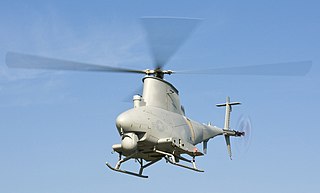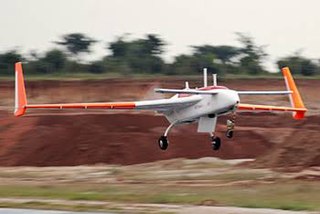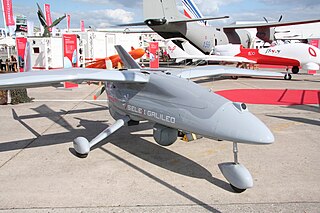Related Research Articles

An unmanned aerial vehicle (UAV), commonly known as a drone, is an aircraft without any human pilot, crew, or passengers on board. UAVs were originally developed through the twentieth century for military missions too "dull, dirty or dangerous" for humans, and by the twenty-first, they had become essential assets to most militaries. As control technologies improved and costs fell, their use expanded to many non-military applications. These include aerial photography, precision agriculture, forest fire monitoring, river monitoring, environmental monitoring, policing and surveillance, infrastructure inspections, smuggling, product deliveries, entertainment, and drone racing.

Merlin is a family of rocket engines developed by SpaceX for use on its Falcon 1, Falcon 9 and Falcon Heavy launch vehicles. Merlin engines use RP-1 and liquid oxygen as rocket propellants in a gas-generator power cycle. The Merlin engine was originally designed for sea recovery and reuse, but since 2016 the entire Falcon 9 booster is recovered for reuse by landing vertically on a landing pad using one of its nine Merlin engines.

The IAI Heron (Machatz-1) is a medium-altitude long-endurance unmanned aerial vehicle (UAV) developed by the Malat (UAV) division of Israel Aerospace Industries. It is capable of Medium Altitude Long Endurance (MALE) operations of up to 52 hours' duration at up to 10.5 km (35,000 ft). It has demonstrated 52 hours of continuous flight, but the effective operational maximal flight duration is less, according to payload and flight profile. An advanced version, the Heron TP, is also known as the IAI Eitan.

A miniature UAV, small UAV (SUAV), or drone is an unmanned aerial vehicle small enough to be man-portable. Smallest UAVs are called micro air vehicle.

The Northrop Grumman MQ-8 Fire Scout is an unmanned autonomous helicopter developed by Northrop Grumman for use by the United States Armed Forces. The Fire Scout is designed to provide reconnaissance, situational awareness, aerial fire support and precision targeting support for ground, air and sea forces. The initial RQ-8A version was based on the Schweizer 330, while the enhanced MQ-8B was derived from the Schweizer 333. The larger MQ-8C Fire Scout variant is based on the Bell 407.

The DARPA Falcon Project is a two-part joint project between the Defense Advanced Research Projects Agency (DARPA) and the United States Air Force (USAF) and is part of Prompt Global Strike. One part of the program aims to develop a reusable, rapid-strike Hypersonic Weapon System (HWS), now retitled the Hypersonic Cruise Vehicle (HCV), and the other is for the development of a launch system capable of accelerating an HCV to cruise speeds, as well as launching small satellites into Earth orbit. This two-part program was announced in 2003 and continued into 2006.

A payload fairing is a nose cone used to protect a spacecraft payload against the impact of dynamic pressure and aerodynamic heating during launch through an atmosphere. An additional function on some flights is to maintain the cleanroom environment for precision instruments. Once outside the atmosphere the fairing is jettisoned, exposing the payload to outer space.

The TAI Anka is a family of unmanned aerial vehicles developed by Turkish Aerospace Industries primarily for the Turkish Air Force. Envisioned in the early 2000s for aerial surveillance and reconnaissance missions, Anka has evolved into a modular platform with synthetic aperture radar, precise weapons and satellite communication.

The Elbit Systems Skylark I and Skylark II are miniature UAVs developed by Elbit Systems. Initial models of the Skylark entered service in 2008.

The IAI Searcher is a reconnaissance UAV developed in Israel in the 1980s. In the following decade, it replaced the IMI Mastiff and IAI Scout UAVs then in service with the Israeli Army.

The DRDO Rustom is a medium-altitude long-endurance unmanned air vehicle (UAV) being developed by Defence Research and Development Organisation for the three services, Indian Army, Indian Navy and the Indian Air Force of the Indian Armed Forces. Rustom is derived from the NAL's LCRA developed by a team under the leadership of late Prof Rustom Damania in the 1980s. The UAV will have structural changes and a new engine. Rustom will replace/supplement the Heron UAVs in service with the Indian armed forces.

The IAI Eitan is an unmanned reconnaissance aircraft developed in Israel in the early 21st century by the Malat division of Israel Aerospace Industries. The aircraft is a newer version of the IAI Heron.

The Orbiter Mini UAV System is a compact and lightweight unmanned aerial vehicle designed for use in military and security applications. It has been used in the Middle East since it was first developed. The system is used for 'Over The Hill' reconnaissance missions, Low Intensity Conflicts and Urban warfare operations as well as any close range ISTAR mission. It is manufactured by the Israeli company Aeronautics Defense Systems.

The Falco is a tactical unmanned aerial vehicle (UAV) designed and produced by Selex ES. The UAV is designed to be a medium-altitude, medium-endurance surveillance platform capable of carrying a range of payloads, including several types of high-resolution sensors. A larger variant, the Falco EVO, is capable of carrying larger payloads is also available. Neither system is designed to carry weapons, The launch customer, Pakistan, reportedly wanted the Falco armed, a request that Italy rejected.

The Elbit Systems Hermes 900 Kochav ("Star") is an Israeli medium-size, multi-payload, medium-altitude long-endurance unmanned aerial vehicle (UAV) designed for tactical missions. It is a successor to the Hermes 450 series of drones, one of the most widely used military drones in the world.

SpaceX manufactures launch vehicles to operate its launch provider services and to execute its various exploration goals. SpaceX currently manufactures and operates the Falcon 9 Full Thrust family of medium-lift launch vehicles and the Falcon Heavy family of heavy-lift launch vehicles – both of which powered by SpaceX Merlin engines and employing VTVL technologies to reuse the first stage. As of 2020, the company is also developing the fully reusable Starship launch system, which will replace the Falcon 9 and Falcon Heavy.

Barak 8, also known as LR-SAM or MR-SAM, is an Indo-Israeli jointly developed surface-to-air missile (SAM) system, designed to defend against any type of airborne threat including aircraft, helicopters, anti-ship missiles, and UAVs as well as ballistic missiles, cruise missiles and combat jets. Both maritime and land-based variants of the system exist.

CATUAV S.L. is a technology-based private company that offers aerial services using unmanned aerial vehicles (UAV). Its headquarters are located in the Moià airfield in the BCN Drone Center, 40 km north of Barcelona, Spain.
References
- ↑ "Innocon cites market interest in Micro Falcon UAV". Archived from the original on 2009-10-30. Retrieved 2011-01-02.
- ↑ "Innocon's Micro-Falcon UAV Highly Successful with Controp's New Stamp Payload Onboard". Archived from the original on 2010-08-10. Retrieved 2011-01-02.
- ↑ "MicroBat'ing Success With Micro Falcon UAV : Satnews Publishers" . Retrieved 2011-01-02.
- ↑ "Micro-Falcon MAV Tests Onboard STAMP Payload" . Retrieved 2011-01-02.
- ↑ "Innocon's Micro-Falcon UAV Highly Successful With STAMP Payload Onboard - ASDNews". Archived from the original on 2010-06-20. Retrieved 2011-01-02.
- ↑ "Micro Falcon". Innocon. Retrieved 15 August 2011.
- ↑ "Peru buys Israeli micro UAV" . Retrieved 2011-01-02.
- ↑ Israel's Innocon Wins Indian Order For Micro Falcon UAV